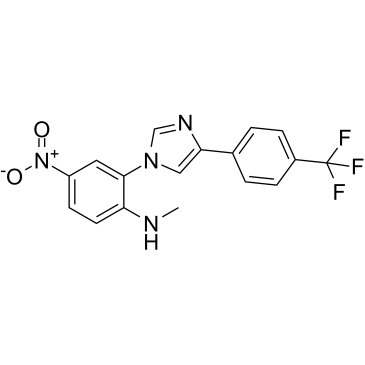CU-T12-9
Modify Date: 2024-01-30 16:07:14

CU-T12-9 structure
|
Common Name | CU-T12-9 | ||
|---|---|---|---|---|
| CAS Number | 1821387-73-8 | Molecular Weight | 362.306 | |
| Density | 1.4±0.1 g/cm3 | Boiling Point | 524.3±50.0 °C at 760 mmHg | |
| Molecular Formula | C17H13F3N4O2 | Melting Point | N/A | |
| MSDS | N/A | Flash Point | 270.9±30.1 °C | |
Use of CU-T12-9CU-T12-9 is a specific TLR1/2 agonist with EC50 of 52.9 nM in HEK-Blue hTLR2 SEAP assay. CU-T12-9 activates both the innate and the adaptive immune systems. CU-T12-9 selectively activates the TLR1/2 heterodimer, not TLR2/6. CU-T12-9 signals through NF-κB and invokes an elevation of the downstream effectors TNF-α, IL-10, and iNOS[1]. |
| Name | N-Methyl-4-nitro-2-{4-[4-(trifluoromethyl)phenyl]-1H-imidazol-1-yl}aniline |
|---|---|
| Synonym | More Synonyms |
| Description | CU-T12-9 is a specific TLR1/2 agonist with EC50 of 52.9 nM in HEK-Blue hTLR2 SEAP assay. CU-T12-9 activates both the innate and the adaptive immune systems. CU-T12-9 selectively activates the TLR1/2 heterodimer, not TLR2/6. CU-T12-9 signals through NF-κB and invokes an elevation of the downstream effectors TNF-α, IL-10, and iNOS[1]. |
|---|---|
| Related Catalog | |
| Target |
TLR2:52.9 nM (EC50, in HEK-Blue cells) TLR1:52.9 nM (EC50, in HEK-Blue cells) |
| In Vitro | CU-T12-9 directly targets TLR1/2 to initiate downstream signaling. By binding to both TLR1 and TLR2, CU-T12-9 facilitates the TLR1/2 heterodimeric complex formation, which in turn activates the downstream signaling[1]. CU-T12-9 activates the TLR1/2 pathway by inducing NF-κB activation to trigger downstream signaling, such as secreted embryonic alkaline phosphatase (SEAP), NO, and TNF-α[1]. CU-T12-9 (0.39-100 μM; 24 hours) does not produce toxicity up to 100 μM in HEK-Blue hTLR2 and Raw 264.7 cells[1]. CU-T12-9 up-regulates the mRNA levels of TLR1, TLR2, TNF, IL-10, and iNOS. CU-T12-9 (0.1-10 μM) activates TLR1 mRNA and iNOS mRNA after Raw 264.7 cells are treated for 24 hours. CU-T12-9 (0.1-10 μM) activates TLR2 and IL-10 mRNA after Raw 264.7 cells are treated for 2 hours. CU-T12-9 (0.1-10 μM) activates TNF mRNA after Raw 264.7 cells are treated for 8 hours[1]. Cell Cytotoxicity Assay[1] Cell Line: HEK-Blue hTLR2 and Raw 264.7 macrophage cells Concentration: 0.39, 0.78, 1.56, 3.125, 6.25, 12.5, 25, 50, and 100 μM Incubation Time: 24 hours Result: No toxicity was seen up to 100 μM. RT-PCR[1] Cell Line: Raw 264.7 cells Concentration: 0.1, 1, 10 μM Incubation Time: 24 hours for TLR1 and iNOS mRNA assay 2 hours for TLR2 and IL-10 mRNA assay 8 hours for TNF mRNA assay Result: Triggered TLR1 mRNA and iNOS mRNA at 24 hours dose-dependently. Dose-dependent activation of TLR2 mRNA and IL-10 mRNA at 2 hours. Showed dose-dependent activation of TNF mRNA at 8 hours. |
| References |
| Density | 1.4±0.1 g/cm3 |
|---|---|
| Boiling Point | 524.3±50.0 °C at 760 mmHg |
| Molecular Formula | C17H13F3N4O2 |
| Molecular Weight | 362.306 |
| Flash Point | 270.9±30.1 °C |
| Exact Mass | 362.099060 |
| LogP | 4.53 |
| Vapour Pressure | 0.0±1.4 mmHg at 25°C |
| Index of Refraction | 1.601 |
| N-Methyl-4-nitro-2-{4-[4-(trifluoromethyl)phenyl]-1H-imidazol-1-yl}aniline |
| Benzenamine, N-methyl-4-nitro-2-[4-[4-(trifluoromethyl)phenyl]-1H-imidazol-1-yl]- |